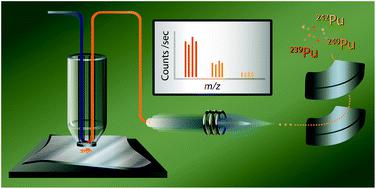当前位置:
X-MOL 学术
›
J. Anal. At. Spectrom.
›
论文详情
Our official English website, www.x-mol.net, welcomes your
feedback! (Note: you will need to create a separate account there.)
Direct analysis of cotton swipes for plutonium isotope determination by microextraction-ICP-MS
Journal of Analytical Atomic Spectrometry ( IF 3.1 ) Pub Date : 2021-09-10 , DOI: 10.1039/d1ja00255d Benjamin T. Manard 1 , Shalina C. Metzger 1 , Kayron T. Rogers 1 , Brian W. Ticknor 1 , N. Alex Zirakparvar 1 , Benjamin D. Roach 1 , Debra A. Bostick 1 , Cole R. Hexel 1
Journal of Analytical Atomic Spectrometry ( IF 3.1 ) Pub Date : 2021-09-10 , DOI: 10.1039/d1ja00255d Benjamin T. Manard 1 , Shalina C. Metzger 1 , Kayron T. Rogers 1 , Brian W. Ticknor 1 , N. Alex Zirakparvar 1 , Benjamin D. Roach 1 , Debra A. Bostick 1 , Cole R. Hexel 1
Affiliation

|
This study demonstrates a method for determining the isotopic composition of low-level (sub-pg) plutonium (Pu) directly from a cotton swipe. Environmental sample (ES) swipes are routinely employed as a tool for monitoring activities in nuclear facilities. Traditional ES swipe analysis, as employed in nuclear safeguards, utilizes laborious ashing, digestion, and chemical separation procedures prior to mass spectrometric (MS) analysis. Here, an innovative sample introduction technique employing a microextraction probe to extract Pu directly from the swipe surface is described. The microextraction probe lowers onto the swipe surface, seals on a small area (8 mm2), and delivers solvent (2% HNO3) to extract actinide material that may be present. The extracted analyte is subsequently directed into a sector field inductively coupled plasma (ICP)-MS for isotope ratio determination. This microextraction-ICP-MS method successfully determined the isotopic composition (240Pu/239Pu and 242Pu/239Pu) of three Pu certified reference materials (CRM 136, 137, and 138) that were deposited (1 pg) onto ES swipes. The percent relative difference from the certified value, uncorrected for instrumental fractionation, was <2% for the 240Pu/239Pu ratio on all three CRMs and <10% for the 242Pu/239Pu ratio on CRM 136 and 138. The percent relative standard deviation, an estimate of the sample-to-sample isotopic precision, was <4% for the 240Pu/239Pu and <15% for the 242Pu/239Pu. Method limits of detection were determined, based on measurements of an enriched 244Pu material, to be ∼7 fg. Additionally, a mixed uranium (U) and Pu deposition was made to determine the method's ability to simultaneously extract U and Pu and determine the isotopic composition of both analytes.
中文翻译:

用微萃取-ICP-MS 直接分析用于钚同位素测定的棉签
本研究展示了一种直接从棉签中确定低水平(亚 pg)钚 (Pu) 同位素组成的方法。环境样本 (ES) 扫描通常用作监测核设施活动的工具。传统的 ES 刷卡分析在核保障中使用,在质谱 (MS) 分析之前利用费力的灰化、消化和化学分离程序。在这里,描述了一种采用微提取探针直接从滑动表面提取 Pu 的创新样品引入技术。微萃取探针下降到擦拭表面,密封在一个小区域 (8 mm 2 ),并提供溶剂 (2% HNO 3) 提取可能存在的锕系元素。提取的分析物随后被导入扇形场电感耦合等离子体 (ICP)-MS,用于同位素比测定。这种微萃取-ICP-MS 方法成功测定了沉积 (1 pg) 到 ES 上的三种 Pu 认证参考材料(CRM 136、137 和 138)的同位素组成(240 Pu/ 239 Pu 和242 Pu/ 239 Pu) . 从认证值,对未校正仪器分馏的百分比相对差,<2%,为240 PU / 239上的所有三个标准物质莆比和<10%为242 PU / 239CRM 136 和 138 上的 Pu 比率。相对标准偏差百分比(样品间同位素精度的估计值)对于240 Pu/ 239 Pu为 <4%,对于242 Pu/ 239 Pu为 <15% 。根据对富集244 Pu 材料的测量,确定方法检测限为~7 fg。此外,还进行了铀 (U) 和 Pu 的混合沉积,以确定该方法同时提取 U 和 Pu 并确定两种分析物的同位素组成的能力。
更新日期:2021-09-16
中文翻译:

用微萃取-ICP-MS 直接分析用于钚同位素测定的棉签
本研究展示了一种直接从棉签中确定低水平(亚 pg)钚 (Pu) 同位素组成的方法。环境样本 (ES) 扫描通常用作监测核设施活动的工具。传统的 ES 刷卡分析在核保障中使用,在质谱 (MS) 分析之前利用费力的灰化、消化和化学分离程序。在这里,描述了一种采用微提取探针直接从滑动表面提取 Pu 的创新样品引入技术。微萃取探针下降到擦拭表面,密封在一个小区域 (8 mm 2 ),并提供溶剂 (2% HNO 3) 提取可能存在的锕系元素。提取的分析物随后被导入扇形场电感耦合等离子体 (ICP)-MS,用于同位素比测定。这种微萃取-ICP-MS 方法成功测定了沉积 (1 pg) 到 ES 上的三种 Pu 认证参考材料(CRM 136、137 和 138)的同位素组成(240 Pu/ 239 Pu 和242 Pu/ 239 Pu) . 从认证值,对未校正仪器分馏的百分比相对差,<2%,为240 PU / 239上的所有三个标准物质莆比和<10%为242 PU / 239CRM 136 和 138 上的 Pu 比率。相对标准偏差百分比(样品间同位素精度的估计值)对于240 Pu/ 239 Pu为 <4%,对于242 Pu/ 239 Pu为 <15% 。根据对富集244 Pu 材料的测量,确定方法检测限为~7 fg。此外,还进行了铀 (U) 和 Pu 的混合沉积,以确定该方法同时提取 U 和 Pu 并确定两种分析物的同位素组成的能力。









































 京公网安备 11010802027423号
京公网安备 11010802027423号